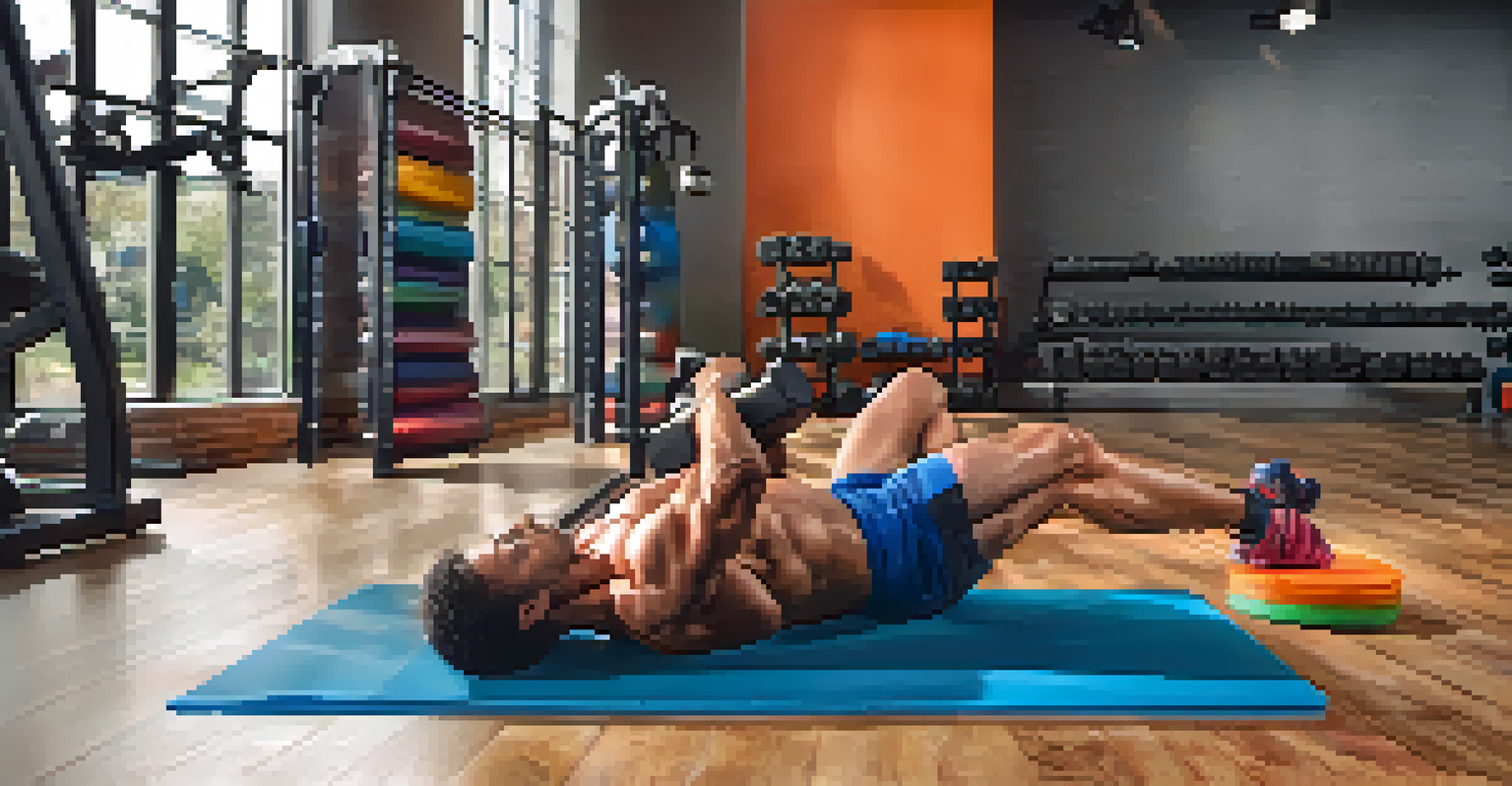Injury Prevention: The Best Cool Down Techniques for Bodybuilders

Understanding the Importance of Cooling Down
Cooling down is a crucial step that often gets overlooked in bodybuilding. After an intense workout, your muscles are pumped and fatigued, and a proper cool down helps transition your body back to a resting state. This phase is essential for preventing injuries and aiding recovery, ensuring that your hard work pays off without setbacks.
The difference between a successful person and others is not a lack of strength, not a lack of knowledge, but rather a lack in will.
When you skip cooling down, your heart rate remains elevated, and lactic acid builds up in your muscles. This can lead to stiffness and soreness, making it harder to train effectively in subsequent sessions. Think of cooling down as a gentle bridge that leads you from the high-energy peaks of your workout to the calm shores of recovery.
Incorporating effective cool down techniques into your routine is not just about feeling good; it’s about longevity in your bodybuilding journey. By prioritizing this essential step, you’re investing in your body’s ability to perform at its best over time.
Static Stretching: A Key Component
Static stretching is one of the most beneficial cool down techniques for bodybuilders. After your muscles have been worked hard, gently stretching them helps to elongate the muscle fibers, promoting flexibility and reducing tightness. Holding each stretch for about 15 to 30 seconds allows the muscle to relax and recover properly.

For example, after a leg day, consider stretching your hamstrings and quadriceps to alleviate tension. Imagine your muscles as a rubber band; if you leave them contracted for too long, they can become stiff and lose their elasticity. Stretching helps restore their natural length and flexibility.
Cooling Down Prevents Injuries
A proper cool down helps transition your body back to a resting state, reducing the risk of injuries and aiding recovery.
Incorporating a variety of static stretches targeting all major muscle groups ensures balanced recovery. This practice not only improves your range of motion but also enhances your overall performance in future workouts.
Foam Rolling: Release Muscle Tension
Foam rolling is a fantastic technique that bodybuilders can use to cool down effectively. This self-myofascial release method helps to break down knots and tension in the muscles, promoting better blood flow and reducing soreness. The pressure applied while rolling can feel intense, but the relief it provides is often well worth it.
Take care of your body. It's the only place you have to live.
Imagine rolling out your muscles like a pizza dough; you’re smoothing out any lumps and ensuring an even surface. By doing so, you encourage optimal muscle function and reduce the risk of injury. Spending just a few minutes on each major muscle group can significantly enhance your recovery.
Integrating foam rolling into your post-workout routine can also enhance your overall flexibility. This technique not only aids in muscle recovery but can also be a relaxing way to end your workout session, leaving you feeling rejuvenated.
Hydration: Don’t Forget to Drink Water
Post-workout hydration is an often underestimated aspect of cooling down. When you exercise, you lose fluids through sweat, and replenishing these fluids is vital for recovery. Drinking water helps transport nutrients to your muscles and flush out toxins, which is essential for preventing injuries and soreness.
Think of your body as a well-oiled machine; without adequate lubrication, things can start to grind and break down. Staying hydrated helps to maintain your body’s performance levels, ensuring your muscles are functioning optimally. Aim to drink water during and after your workout to stay ahead of dehydration.
Static Stretching Enhances Flexibility
Incorporating static stretching after workouts promotes flexibility and reduces muscle tightness, improving performance in future sessions.
In addition to water, consider electrolyte-rich drinks if your workouts are particularly intense. This can help restore the balance of essential minerals lost through sweat, further aiding in your recovery process.
Breathing Exercises: Relax and Recover
Incorporating breathing exercises into your cool down can significantly enhance relaxation and recovery. Deep, controlled breathing helps to lower your heart rate and promotes a sense of calm, allowing your body to transition from the stress of exercise to a restful state. This practice can be particularly beneficial after high-intensity workouts.
For instance, take a few moments to sit or lie down comfortably, inhaling deeply through your nose and exhaling slowly through your mouth. Visualize your body releasing tension with each exhale, much like a balloon deflating. This mindful approach can make your cool down feel more intentional and restorative.
By integrating breathing exercises, you not only support muscle recovery but also improve your mental focus. A calm mind can enhance your training sessions, fostering a stronger connection between your body and your goals.
Active Recovery: Keep Moving Gently
Active recovery is a wonderful technique for bodybuilders looking to cool down effectively. Rather than stopping abruptly after an intense workout, engaging in low-intensity activities can help maintain blood flow and prevent stiffness. Activities like walking, light cycling, or gentle yoga can be great options.
Imagine your body as a river; keeping it flowing gently allows for a smooth transition rather than a sudden halt. This gradual decrease in intensity can help remove lactic acid buildup and support muscle recovery, making you feel less sore the next day.
Hydration Supports Recovery
Replenishing fluids post-workout is essential for muscle recovery and helps prevent soreness, keeping your body functioning optimally.
Incorporating active recovery not only benefits your muscles but can also enhance your overall conditioning. It’s a fantastic way to remain engaged with your fitness routine while allowing your body to recover.
Listening to Your Body: Know When to Rest
One of the most important aspects of injury prevention is learning to listen to your body. Post-workout, pay attention to how your muscles and joints feel. If you notice any unusual pain or discomfort, it might be a sign to take a step back and prioritize rest or recovery techniques.
Imagine your body as a car; if you hear strange noises, it’s wise to take it to a mechanic rather than risk a breakdown. By tuning into your body’s signals, you can identify when it needs more time to recover and when it’s ready to push forward.

Rest days are just as crucial as workout days, and they play a significant role in injury prevention. Giving your body adequate time to recover ensures that you’re always performing at your best, reducing the risk of overuse injuries.
Consistency is Key: Make Cooling Down a Habit
Establishing a consistent cool down routine is vital for long-term injury prevention. Just as you wouldn’t skip your warm-up, make cooling down an integral part of your workout process. The more habitual you make it, the more your body will adapt and respond positively.
Consider setting aside just 10 to 15 minutes after each workout for your cool down. This small investment of time can lead to significant improvements in your recovery and performance. It’s a simple way to show your body the care it deserves.
Over time, you’ll likely notice a decrease in muscle soreness and an overall enhancement in your workout performance. By making cooling down a non-negotiable part of your routine, you’re paving the way for a healthier, more sustainable bodybuilding journey.